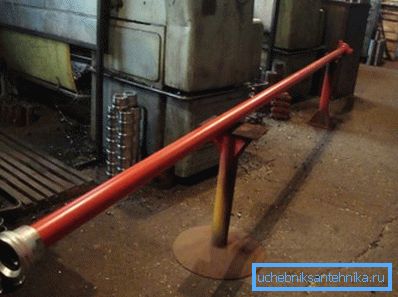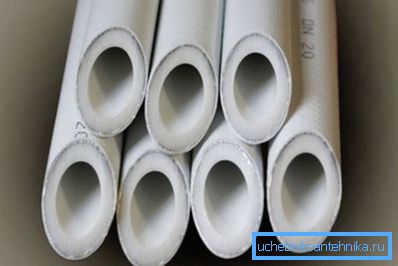High pressure pipes - types and applications
The main task of any pipeline is to transport liquid or gas, and, in some cases, it is carried out under high pressure. For the installation of such pipelines, high-pressure steel pipes are most often used, which meet all the necessary strength requirements. Next, we consider the types of such pipes and their application.

Types of high pressure pipes
To transport liquids and gases under high pressure in the modern world is required very often, for example, such pipelines are found:
- In the oil industry;
- In mechanical engineering;
- Various hydraulic systems, etc.
Of course, in different applications, the requirements for these products are different. Therefore, below we take a look at their main types.

Hydraulic
As it is easy to guess from the name, a high pressure hydraulic pipe is used when installing a hydraulic pipeline and various pneumatic systems. In addition, they are used in construction and agricultural machinery, special equipment, etc.
In fact, this product is an ordinary seamless cold-drawn pipe, manufactured according to GOST 9567-75 and GOST 8734-75. Such a product may have the following dimensions:
| Outside diameter | 4-42 mm |
| Wall thickness | 1-2 mm |
| Length | No more than 6 m |
Tip! If the pipeline is damaged, it is possible to repair high-pressure pipes using conventional electric welding.

The production process consists of the following steps:
- The first is the preparation of blanks;
- Then, the billet is cold rolled;
- Then cold drawing is performed (in some cases rolling and drawing are combined);
- After that, the finished products are thermally and chemically treated.
The final stage is quality control, in particular, the products are checked for resistance to hydraulic pressure, flattening, bending, etc. It should be noted that the manufacture of high-pressure pipes with a diameter of 4 mm is carried out according to the same scheme.
Note! This product can be made of both ordinary and stainless steel.
Installation of the pipeline, as a rule, is carried out by welding or flaring.

Manifold
High pressure pipe (TVD), as already mentioned above, is also used in the oil industry. It is used for pumping oil with a high fraction and further pumping water into the well, which allows you to lift oil above the surface of the liquid.
The main feature of the theater is the ability to withstand very high pressure - 70 or more MPa. This possibility is achieved due to thick steel walls, the thickness of which is proportional to the diameter - 5 mm and diameter 60 mm.
As for the length, it can be:
- 4000 mm;
- 2000 mm;
- 1100 mm.
This product is manufactured according to GOST 633-80. The steel grade depends on the type of mixture being pumped, but the most commonly used steel is “20”. To provide protection against corrosion, the product is covered with red enamel NTs-132.
It must be said that the products must pass hydraulic tests under a load of 130 Pa (with a wall thickness of up to 12 mm).
Seamless steel for fuel lines
Seamless tubes for diesel fuel lines are made of steel grade 20 according to GOST 11017-80.
The characteristics of these products are as follows:
- Length - 0.5 to 6 m.
- Relative lengthening - makes not less than 21%.
- Temporary resistance - must be at least 392 N / mm2 /.
- Internal diameter - 2 mm.
- Outer diameter - 6-7 mm.
Note! By agreement with the customer, this product can be made of other steel grades, for example, 15XM, 30, 10, etc. The price of the product may depend on the steel grade.

Plastic pipe
Often you can hear such a thing as "high pressure plastic pipe." Immediately it should be noted that “high pressure” in this case is very relative, since “plastic” is not able to withstand such loads as steel. However, it is enough to withstand the pressure in the plumbing or heating system.
Therefore, plastic pipes are used in domestic pipelines.
Most often they are made of the following materials:
- Polypropylene (to increase strength, they are reinforced with aluminum or fiberglass).
- Polyvinyl chloride.
- Polyethylene
When installing water pipes and heating systems, this material has become much more popular than the metal counterpart, which is associated with a number of their advantages:
- Corrosion resistance;
- Affordable cost;
- The ability to do their own hands installation, even a layman;
- Durability - the pipeline can serve up to 50 years;
- Resistance to chemically aggressive environments;
- High speed installation;
- Maximum pressure up to 2.5 MPa at operating temperature.
The diameter of these products is in the range of 16 - 630 mm. The diameter of domestic pipelines is usually 20 - 32 mm.

For installation of most types of plastic pipes use a special welding machine.
Brief instruction is as follows:
- First of all, you need to connect the welding machine to electricity and heat it to the operating temperature, which will be indicated by the indicators.
- If it is necessary to connect an aluminum-reinforced pipe, it is first necessary to remove the top layer of material with reinforcement using a special tool (stripping).
- Then, the parts to be soldered should be inserted into the soldering iron nozzle and wait until the material softens.
- After that, the parts need to get out of the nozzle and connect with each other. In this position, they must be held until the plastic freezes. If you didn’t manage to make a high-quality joint the first time, you should cut off the soldering point and perform the procedure again.
According to this scheme, all the details of the pipeline are connected into a single system.
Here, perhaps, are all the main points of high-pressure plastic pipes.
Conclusion
Currently, there are a great many pipes designed for high-pressure pipelines. All of them are designed for different purposes and different operating conditions, with the result that they have different properties and characteristics. Therefore, products should be selected in accordance with their purpose.
From the video in this article, you can get more information on this topic.